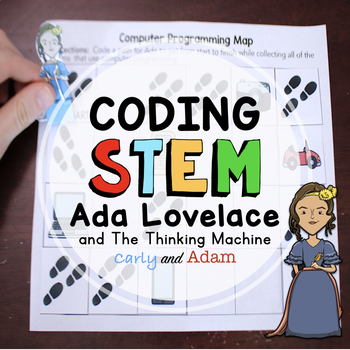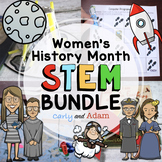Ada Lovelace Unplugged Coding Activity
- PDF
- Easel Activity
What educators are saying
Also included in
- Integrate STEM and Social Students during Women's History Month in your makerspace, STEM Club, Library, and 1st Grade through 5th Grade classroom! Teach students that anyone can be successful in STEM and important leaders in our world regardless of gender.Build a lunar lander to help Apollo AstronauPrice $10.00Original Price $13.00Save $3.00
- Integrate STEM and Literacy in your classroom all year with READ ALOUD STEM Volume One! Everything you need to be the master STEM Teacher at your school! Awaken imagination and creativity all year. Students learn coding, engineering, explore real-world problems, learn about STEM role models, pioneerPrice $100.00Original Price $158.50Save $58.50
Description
Integrate coding in your classroom with an Unplugged Coding Women's History Month STEM Activity!
Ada Lovelace and The Thinking Machine Coding Challenge is a fun and unique way to engage your students during Women's History Month. Teach students that anyone can be a scientist regardless of gender. Ada Lovelace created a system that influenced modern day coding!
Students begin the activity by reading about Ada Lovelace. We included our own mini reading passage, and you can also use Ada Lovelace and The Thinking Machine by Laurie Wallmark or Who Says Women Can't Be Computer Programmers by Tanya Lee Stone.
Students work together to create different codes to lead Ada to collect different types of technology that use coding. Every activity and solution is unique as students create their own board and code by moving the start point, objects that use computer programming, and end points on their coding sheets.
After they have completed their activity, there is time for reflection on what worked and what didn't.
This activity is completely unplugged, and no robots are required. Amazing resource for STEM club, coding club, STEM teachers, technology teachers, elementary librarians, parents who love hands-on learning, and elementary teachers who want to create a hands-on educational environment in their classroom! Perfect activity for Hour of Code.
Material List:
- Scissors
- Ada Lovelace and The Thinking Machine by Laurie Wallmark or Who Says Women Can't Be Computer Programmers by Tanya Lee Stone (Recommended)
Includes:
- Teacher Instructions
- Student Instructions
- Student Coding Ada Lovelace Activity
- Student Reflection Sheets
- Ada Lovelace Mini Reading Passage
- TpT Digital Version for Distance Learning with Google Classroom
Digital Activity:
To use Easel for Distance Learning, select "Open in Easel" on this listing.
Follow us!








